Have you ever thought about the amount of data that surrounds you daily? How about the volume of data in your business life? Here are some staggering stats.
Every second of 2020, Facebook users sent 150,000 messages, YouTube users uploaded 500 hours of videos, and Instagram users posted 347,222 stories (according to the Data Never Sleeps report).
The question is, how is it possible to handle information you can’t control and use it for your business benefit? That’s when unstructured data management comes into play.
If you’ve never paid much attention to unstructured data, we’re here to help you fix that. Learn why it’s important, how to make it work for you, and what tools to use — this article answers all your troubling questions about unstructured data.
What Is Unstructured Data?
Unstructured data is any type of information that is not stored in a traditional database or spreadsheet. Examples of unstructured data include text (e.g., user reviews, documents, or social media chat history) and non-text content (e.g., visuals and sound). Geographical and IoT streaming info are among the newer types of unstructured data.
Even though unstructured files play a crucial role in the growth of organizations, proper management is still a challenge for the vast majority of businesses. Take a look at the survey results provided by Sail Point in collaboration with Dimensional Research (March 2021):
- 99% of respondents experience challenges in managing unstructured data sets;
- 76% report unstructured data issues in the organization;
- Almost half of the respondents (42%) don’t know where some types of organizational information are located.
The amount of data in the world won’t stop growing anytime soon. In 2020, it reached 64.2 zettabytes (64.2 billion terabytes) and is expected to reach 180 zettabytes by 2025 (Statista). So the sooner you solve the management riddle, the more successful you’ll be in the competitive market.
Structured Data vs. Unstructured Data vs. Semi-Structured Data: What Is the Difference?
The well-known term ‘big data’ comprises three data types: structured, unstructured, and semi-structured. To gain value from each of them, you should know the key differences between the three.
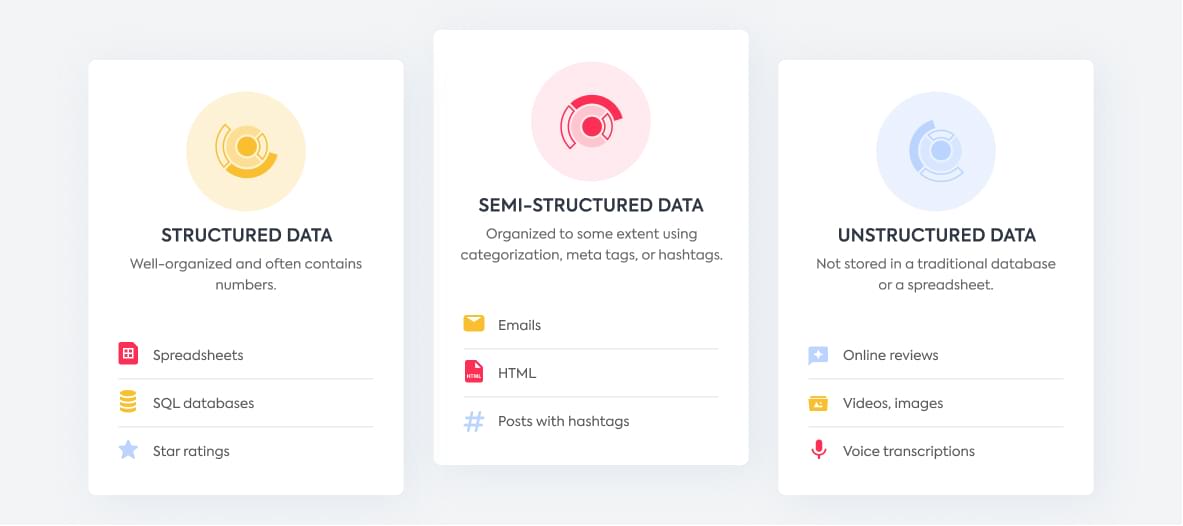
- Structured data is well-organized and often contains numbers. In other words, it is already built in some structure (spreadsheets, PoS systems, SQL databases, etc.), which makes it easy to find specific information, categorize it, and compare data pieces. Examples: names, gender, age, billing info, addresses, etc.
- Unstructured data is not that simple. It is usually a large portion of text, an image, or a sound that you can’t put into a spreadsheet right away. Examples: documents, customer feedback, social media posts, voice transcriptions, call center recordings, etc.
- Semi-structured data also can’t be inserted in a sheet but is still organized to some extent using categorization, meta tags, or hashtags. In other words, this information is grouped, but there is no structure within each group. Examples: emails, HTML, NoSQL databases, resource description frameworks (RDFs), etc.
Unstructured Data Examples: Detailed Overview
Now, let’s take a look at several real-life examples of the types of unstructured data. This overview will help you understand how much unstructured information your business stores compared to structured data.

Documents
We’re starting off with business documentation, the broadest category of content. Reports, presentations, and legal documents contain lots of unstructured data. And even though they form a big portion of the organization’s knowledge base, lots of information remains unused because it’s not structured.
To get the most out of this data, companies should use text analysis. It’s a machine learning technique used to identify valuable pieces of information through natural language processing (NLP).
2. Webpage content
Any webpage contains text and images. The bigger the website is, the more unstructured files it includes: videos, audio, and fill-in forms.
While websites are created with HTML (semi-structured data), the code itself can’t grasp the page’s full meaning and value. However, web pages may contain insights on customers and competitors that can help companies to understand the market better.
In this case, machine learning is also the best tool to use. It helps to mine valuable information, then arrange and continuously track it.
3. Media content
Nowadays, anyone can produce images, video, or audio content — from smartphone users all the way up to entertainment companies. This data is stored in databases, but we still don’t know what the content is all about.
Understanding and analyzing media files may be of value to various industries. For example, video analysis in a shop may help retailers better understand customers’ behavioral patterns. To make this possible, business owners should turn to NLP (to get text content out of audio files) and then use sentiment analysis.
4. Social media activities
Social media is all over the place: photos, videos, comments, opinions, likes, and statistics. It can be somewhat categorized using hashtags, but social media content is unstructured for the most part. And don’t forget that businesses and individuals unceasingly interact on social media platforms.
This active participation is a true treasure for business owners who want to know their target audience better and understand typical preferences and behaviors. One of the best machine learning methods to use for that is the event detection algorithm.
5. Customer feedback
Positive customer feedback demonstrates that you’re moving in the right direction, while negative feedback hints at weak spots that need your attention. In any case, this is one of the most valuable indicators of business success and one of the most difficult to analyze.
Feedback may come in the form of a Google review or a phone call. No matter what the feedback looks like, it can take a structured form with the help of machine learning methods.
6. Survey responses
Marketing or employee questionnaires often contain several open-ended questions. They provide a better understanding of the interviewee’s opinion or decision-making process. And this text, unlike closed-ended answers, is unstructured information, which is naturally harder to process.
Let’s figure out what types of unstructured data you need to process first
Contact us
To interpret the data faster and more productively, you should use AI and natural language processing techniques. They save lots of time and reduce the human factor impact on the research.
7. Chat recordings
These days, communication takes many forms and often happens online via messengers, video, and audio conferencing tools. If, for example, your company has a customer support department, it processes lots of data every day, and this data is often the most valuable information about your customers.
Using technology, you can first transcribe voice into text. Speech emotion recognition will help categorize the customer’s mood, while natural language processing will identify conversation themes and products mentioned.
What Are the Key Benefits of Unstructured Data Management for Your Business?
As you can see, unstructured information can be found in every business department. But is it worth your effort?
First, what is unstructured data management? These are activities aimed at collecting, organizing, and structuring the files with no established structure in the first place.
Now, let’s get to the list of potential benefits you can gain if you decide to manage all data flows, including unstructured ones.

Optimized workflow
With a data management system set up, your employees will always know where to find required information and how to use it. It reduces extra time needed to find a document and, subsequently, allows a team to focus on the core responsibilities.
2. Improved decision-making
“Information is a source of learning. But unless it is organized, processed, and available to the right people in a format for decision making, it is a burden, not a benefit”. — William Pollard
Only complete information transparency leads a business to fruitful results. Make sure you’ve done everything possible to gather data from each department and provide your team with an overall vision. Soon, you’ll see how it leads your employees to quick and effective results based on facts.
Read more on AI decision-making and how unstructured data management can help it.
Read more
Polished customer experience
Unstructured data management tools allow you to constantly monitor client communication channels: phone calls, live chats, reviews, emails, etc. The next stage is to automatically transform client requests into tickets for your support team. There’s no faster way to respond to your clients’ needs.
In the same way, you can follow up with the online content mentioning your brand’s name. You can track your presence on all social media platforms in real time with no extra effort.
4. Safer information environment
The more data gets overlooked, the more security threats your business will face in the future. How can you protect something if you don’t know it exists, right? Complete information transparency and regular backups significantly reduce the risk of cyberattacks.
5. Clear market vision
Just like you’re tracking your data, you can monitor your competitors. Every company leaves a trace on the Internet; you only have to follow it. Social media and blog posts, press releases, and customer reviews — you will quickly analyze all this using AI and machine learning technologies.
By analyzing others, you will better understand your place in the market and discover areas for improvement. What is trending now? And what may come next? Information is one of the key factors for your market growth.
6. Timely regulatory compliance
What if some of your business documentation doesn’t meet legal requirements? The risk is much higher if you don’t manage your company’s data properly. But if your unstructured information is always on display, you’ll be aware of areas that need your attention the most.
What Challenges to Expect in Unstructured Data Management
“By failing to prepare, you are preparing to fail”. — Benjamin Franklin
We’ve gathered the most challenging issues in managing unstructured data in the organization with recommendations on coping with them.

Low data quality
Unstructured docs are diverse, so it’s no surprise that some pieces could be of poor quality (e.g., duplicates, long-form paragraphs, email or social media threads, etc.).
What should you do?
Keep this in mind before scanning starts. The better work you do on the cleaning-up part, the faster you’ll collect the data.
2. Disjointed data pieces
Information scattered among company departments is an issue familiar to any business owner. However, separated data storages create difficulties for effective data collection.
What should you do?
Make sure specialists in your company can provide solid and reliable data routing and then systematize all files you have from different departments.
3. Time-consuming data collection
Just the idea of managing thousands of unstructured documents seems overwhelming. But nobody considers the time needed to scan and gather all information in place.
What should you do?
The best option is to use technology optimized for fast scanning without time-consuming data parsing.
4. Proper data protection
For many companies, it’s extremely challenging to provide daily backups for all data categories because of their vast size. Instead, businesses select particular information, putting all other data pieces at risk.
What should you do?
Incremental backup might be your best option. It saves only the information created or modified over a given time. This reduces the needed storage space and allows for a quicker backup workflow.
5. Future data growth
The amount of unstructured data in your company will continue to grow in parallel with your business, which will require more storage and investments with time.
What should you do?
Carefully choose your storage options and make sure to compress data as much as possible (but keep it in decent quality). Cost optimization should start at the earliest stage to make further adjustments simpler for your budget and employees.
How to Manage Unstructured Data Successfully
Now that you understand the importance of managing unstructured data, how does it all happen? Below, we have a six-step guide that shows you the unstructured data management process from start to finish.
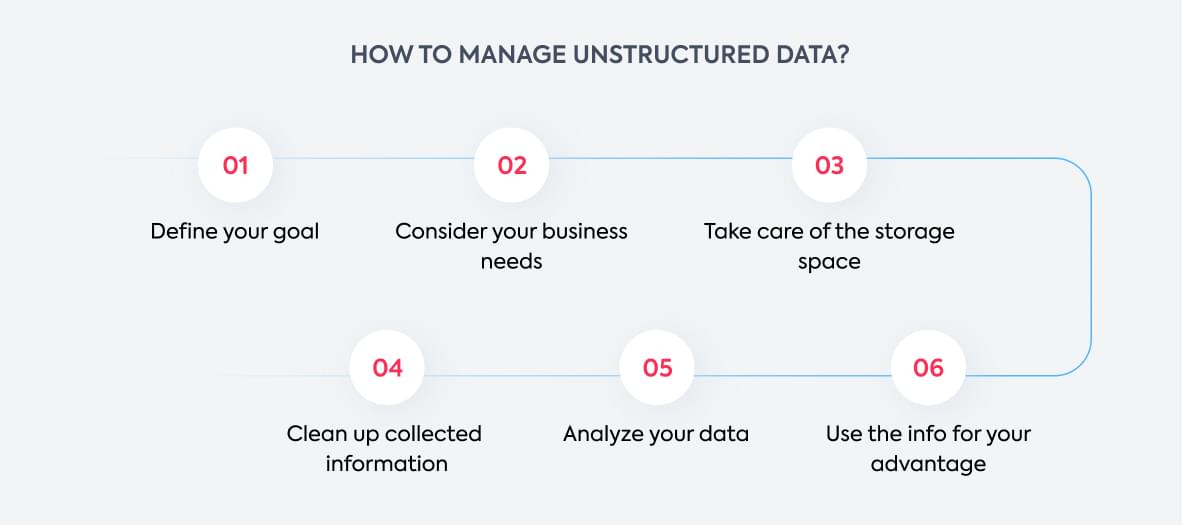
Define your goal and required type of content
Gathering and structuring information is not just some fancy trend — it should serve a definite purpose in your company. First, ask yourself why you need to keep unstructured data in order.
Here are some ideas:
- Analytics of customer preferences;
- Social media presence and PR;
- Gaps in organization processes;
- Wear-and-tear analytics of the production equipment;
- The team’s productivity;
- Etc.
You probably don’t need to collect all the data right away, but instead, focus on a certain type that fits your current needs. Start there and move step by step from one foreground issue to another.
2. Consider your business needs and capabilities
Now let’s look broadly at your business. There are several things to consider beforehand:
- What security level is required for this type of data? Several industries, such as finance and healthcare, need double security protection.
- What is your current budget for data management? Will it change in the future?
- Are there crucial business strategy points to keep in mind? For example, prospective startups should be ready for intensive documentation growth in their organization.
3. Take care of the storage space
Your answers to the questions above will help you decide on the storage space to use. The most popular data storage types follow:
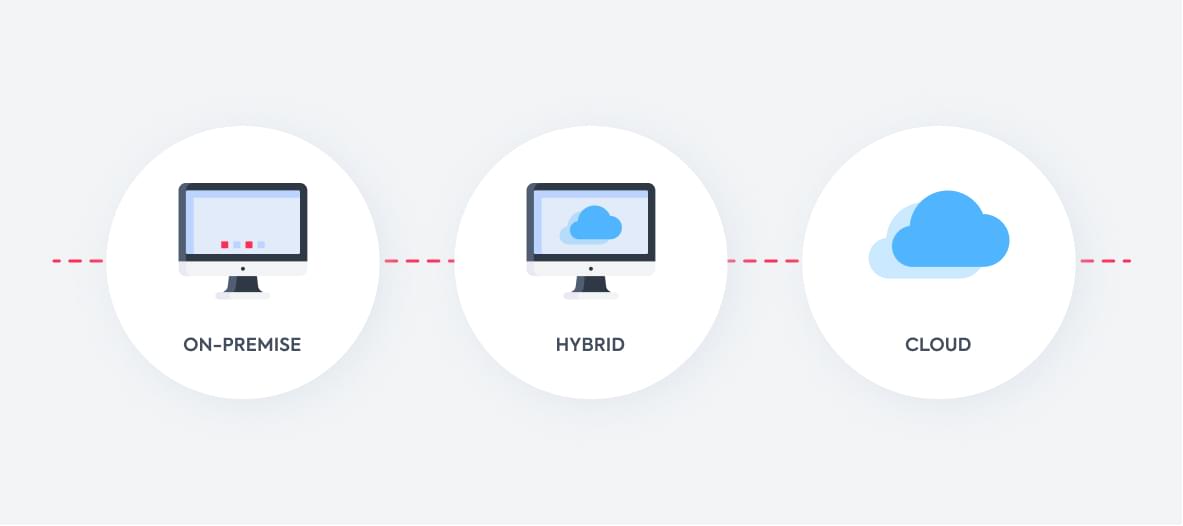
- A public cloud is a go-to option for many It has the easiest accessibility and scalability: when your data grows, you can buy more space in no time. The most popular clouds are Google Cloud, Azure, and Amazon. According to Statista, 64 percent of respondents use SharePoint to store unstructured docs.
- On-premises hardware is for those concerned about data security issues. A company buys a server and stores critically important files in-house. But you should also consider that technical support for this will involve a bigger budget.
- The hybrid approach includes using the first two options for different purposes. It’s the most obvious option for enterprises storing a lot of data, some of which requires advanced security layers.
To make your storage user-friendly, provide it with metadata and a search feature with filters.
4. Clean up collected information
Unstructured data usually doesn’t follow any order and contains mistakes and extra characters that create challenges for AI algorithms. Hashtags, misspellings, HTML tags — all of it must be cleaned up before analysis starts.
Set up a smooth unstructured data management process with our team!
Contact us
Pay attention to these points:
- Spelling. Social media, for example, is full of slang words and nonstandard word forms (like “tnx” or “luv”). The same goes for merged words (“sunnyweather”) and letter transposition (“tahnk you so mcuh”).
- Formal (names of organizations) and informal (social media reductions) abbreviations. Depending on the type of content, you should consider if there are several meanings for one abbreviation in the context.
- HTML tags. They only create extra noise in the text and don’t bring any value to the overall meaning.
- Long paragraphs. If you focus on business reviews, longer paragraphs usually concern detailed customer opinions. To distinguish valuable insights, you should first break a paragraph into several small ones.
Here are several tools to help you clean up your data:
5. Analyze data with AI/ML technology
Generally speaking, you have two main ways of managing unstructured data: you can find ready-made solutions available on the market or create one with a development team, depending on your initial goals. Sometimes, it’s better to have a custom tool if your business needs differ from the standard market demands.
All solutions currently available in the market are based on machine learning (ML) technology. They classify unstructured data sets by their topic, general message (point of view), purpose, and more. But ML capabilities are way broader, and we’ll tell you about them in terms of our experience (see the article’s final section about CHI Software’s expertise).
6. Use the info to your advantage
Unstructured data analysis often brings unexpected results that hint at the weak spots in your organization. This is your golden opportunity — use these insights now to fill in existing gaps.
Using ML solutions to manage unstructured data, CHI Software clients have reduced equipment operating costs, automated business processes, and expanded target audience segmentation to offer a personalized experience to the customers.
Unstructured Data Management Tools and Solutions for Your Business
Is a ready-made solution enough for your company? Let’s review popular unstructured data management solutions to help you make a decision.
This is a helpful tool to manage unstructured data, including comment sections and books.

Key features:
- Ability to analyze large amounts of information;
- Flexibility in working with data entities: you can use predefined options, define them yourself, or create new ones from scratch;
- Document filtering available for theme detection;
- Easy importing of your documents;
- Visual result representation for better understanding.
You’ll need a developer’s help with this one. The solution does not require ML knowledge, but still, you need to integrate an API into your business software. By the way, there are 30 APIs to choose from.
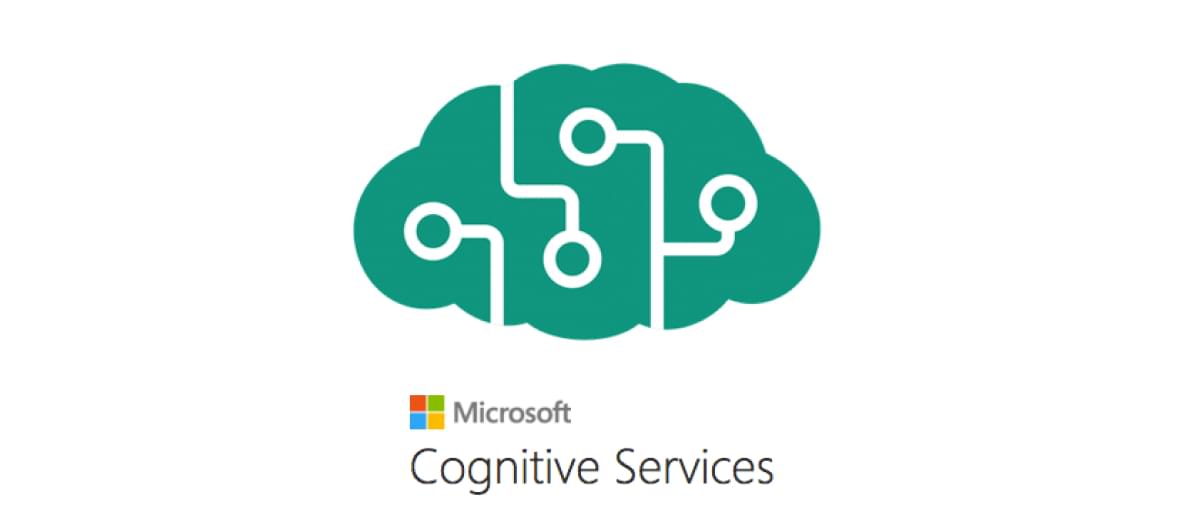
Key features (API groups):
- Decision APIs help to find anomalies in the text, moderate content, and personalize user experience;
- Search APIs are focused on Bing’s provided content (search within the Bing news, videos, autosuggest, images, etc.);
- Vision APIs provide advanced technologies for visual search among images and videos;
- Speech APIs help to set up speech processing;
- Language APIs help to build advanced chatbot features.
Here’s another solution based on the cognitive capabilities to analyze text and its emotional coloring.
Watson is a computer system previously built by IBM that can answer questions asked in natural language. It’s named after one of the IBM founders, Thomas J. Watson.
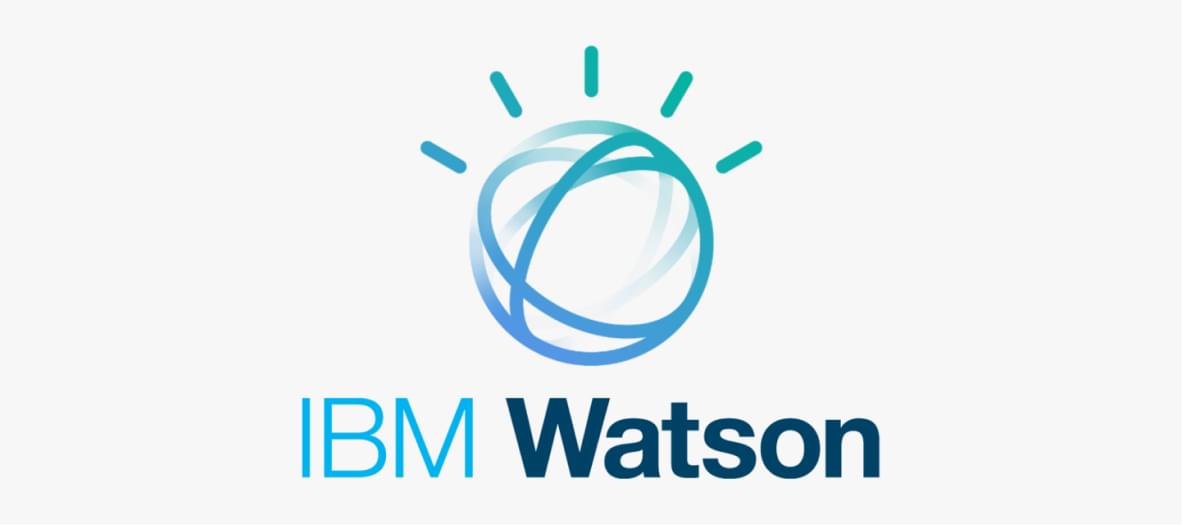
Key features:
- AutoAI to automate data preparation;
- Text Analytics feature to fully uncover unstructured data;
- Powerful engine to create sophisticated visuals;
- Dashboards to gather and share collected insights.
This tool is based on using intelligent tags to help you filter out unstructured data. Adata tag is an <element> added to a standard text, allowing for data classification and simplified search-through.

Key features:
- Finding repetitive patterns in the data sets to decide what parts to tag;
- Scanning word variations (with errors or duplications) to consider them when tagging;
- White list feature to set apart homonyms;
- Ability to develop customized dictionaries;
- Tool to put synonyms together.
WordStat is a QDA Miner module that analyzes text, content, and sentiment from unstructured data sets.

Key features:
- The software processes 25 million words per minute;
- Explorer mode to quickly distinguish the most frequently occurring words and phrases as well as main topics;
- Numerous sources to import unstructured data (Word, Excel, XML, HTML, PDF, etc.);
- Identifying connections between words, phrases, and concepts;
- In-built dictionaries for full automation, etc.
How Can the CHI Software Team Help You Manage Unstructured Data?
Every business has unique needs and characteristics, requiring custom tools to deal with unstructured data. From our experience, we can tell you that the final set of features may vary hugely. Here are several examples.
Solution for Consumer Analytics
Our client is a global consumer data analytics company offering trustworthy business insights. At a certain point, the client didn’t have enough tools to process the big data of TV viewers’ preferences.

Our team created a user-friendly platform that helps to collect, process, and deliver results to improve customer analytics. This solution allowed our client to understand viewers better, expand market segmentation, and make personalized offerings to each audience group.
Price Tag Tracker
Our client is an international retail chain with more than 500 stores across Europe. Each store has around 5,000 items on the shelves, which makes manual price tag tracking and updating time-consuming and susceptible to human error. Plus, outdated updating caused revenue losses.

CHI Software created a module as a part of the client’s CCTV system. The tool has a computer vision feature that collects price tag images. Then, an NLP feature processes this information and compares it with the prices available in the system. Finally, the module identifies tags that need updating in real time, and employees get notifications on the tags they need to change.
Connected Cars X
Our client is a taxi service trying to identify the reasons for fast car detail deterioration that impacted repair and insurance expenses. This issue required real-time data collection of different parameters.
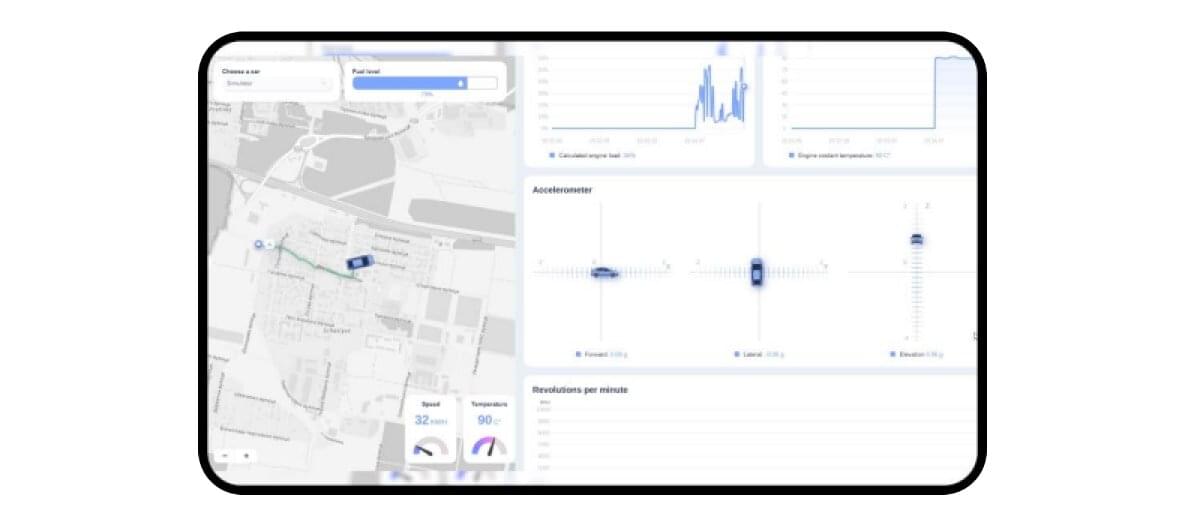
Our team created a solution that analyzes the vibration level, optimal speed, driving and aggressiveness scores, etc. It gives a complete overview of the trip and allows our client to notice and predict operational “blind spots” and plan expenses beforehand.
Conclusion
Unstructured data is here to stay, and it will only extend in the future. These are the key takeaways from this article:
- Unstructured data includes business documents, social media posts, and customer feedback in voice and text forms, and there’s hardly a limit to it;
- 99 percent of businesses face challenges in unstructured data management;
- You can’t manage unstructured data without knowing why you need to do it in the first place;
- Your data management budget directly impacts the amount of data you’ll be able to collect and process;
- All unstructured data management tools are based on machine learning and artificial intelligence technologies;
- With unstructured data, you potentially can improve inner working processes and your relations with clients, regardless of the niche and industry you work in.
Be ahead of the game by managing your unstructured data!
Contact us
About the author
Polina Sukhostavets
Content Writer
Polina is a curious writer who strongly believes in the power of quality content. She loves telling stories about trending innovations and making them understandable for the reader. Her favorite subjects include AI, AR, VR, IoT, design, and management.















